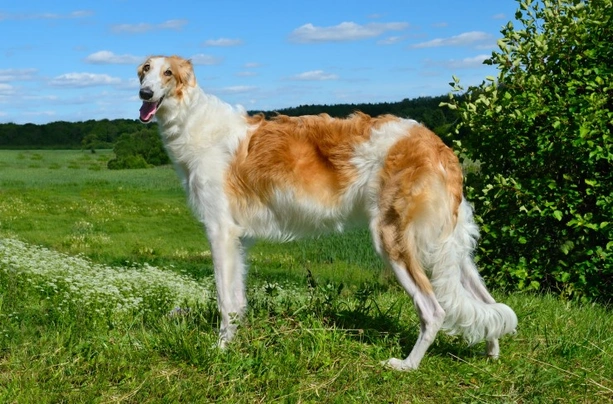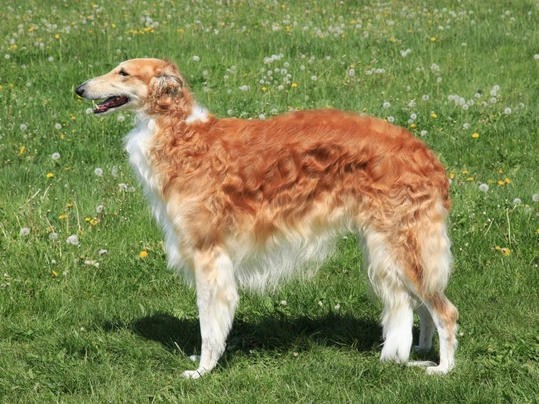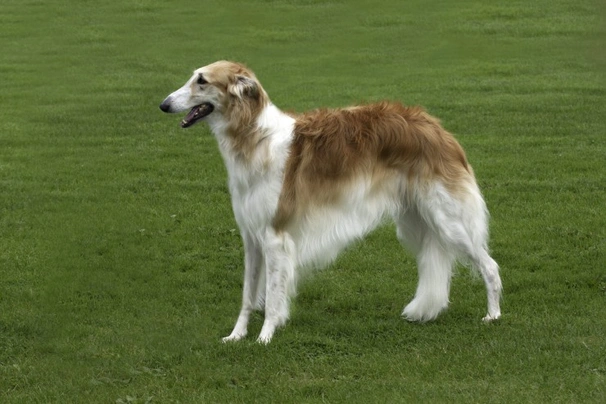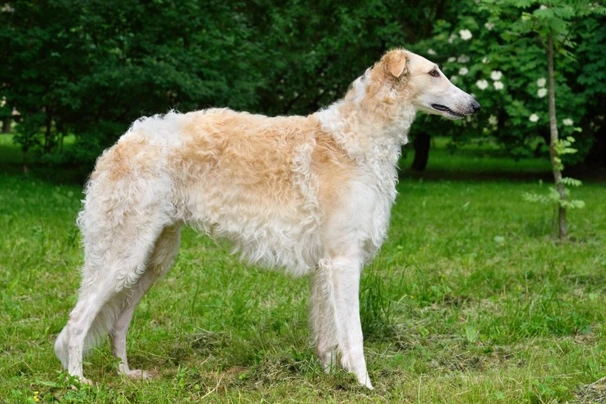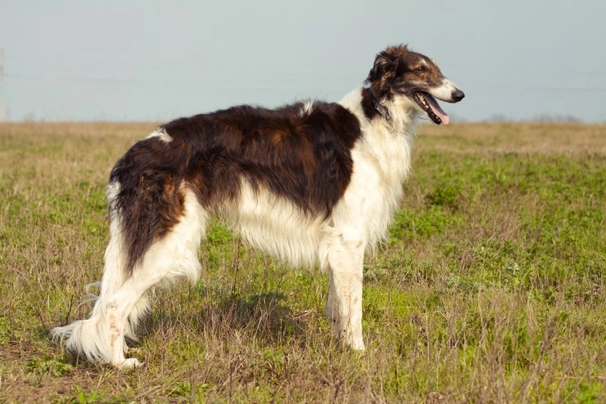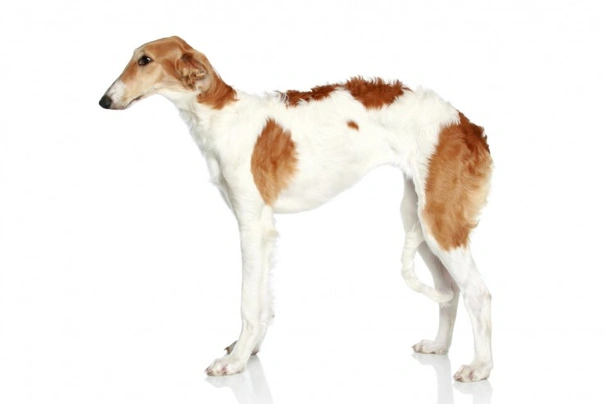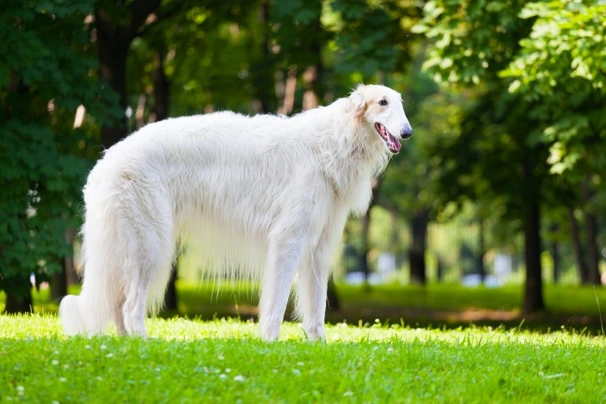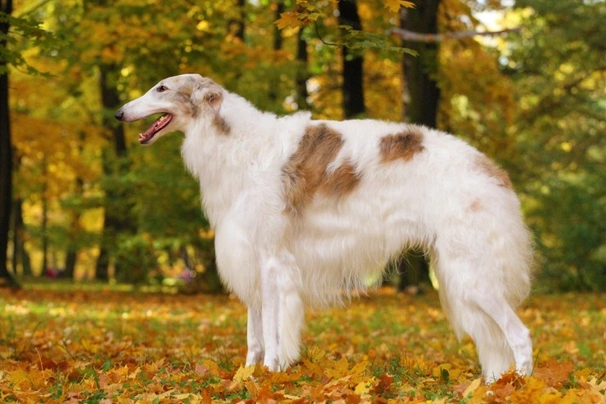Borzoi
Pros
Cons
Introduction of the Borzoi
The aristocratic Borzoi is native to Russia where they were used to hunt wolves. Their name means "swift" in Russian and just looking at these elegant dogs with their sleek athletic build offers an insight into how quick they are when the need arises. The first person to own a Borzoi in the UK was Queen Alexandra when she was offered one as a gift by the Tsar of Russia. From then on the breed was to become a much noticed and popular dog throughout the country as well as elsewhere in the world.
However they are not a breed to take on too lightly for several reasons with the first being their large size which means they need enough room to express themselves as they should. The second reason being that these dogs should be trained by someone familiar with the breed and a sighthounds specific needs. On top of this a Borzoi needs to be given a ton of daily exercise for them to be truly happy well-rounded dogs in short they are better suited to people who live in the country and who lead active outdoor lives.
History of the Borzoi
The exact origins of this graceful hound remains a bit of a mystery but some people believe the breed was developed way back during the 9th and 10th centuries and that the Saluki may well have been used to create these elegant graceful courageous and extremely fast dogs.
What is known is that the Borzoi is Russia's most well-known hound and that they were used during the 17th century to hunt wolves. It was a Russian Duke who first imported a number of sighthounds after having travelled to Arabia. These dogs were not robust or strong enough to survive Russia's harsh winter temperatures so the Duke imported several more of these sighthounds only this time he crossed the hounds with native breeds which are thought to have been coursing hounds or shepherd dogs used by the Tartars back in the day.
The Borzoi soon became a popular gift offered to European royals by the Czars of Russia and the sighthounds soon became a firm favourite thanks to their kind placid natures and exotic looks. In 1903 a man called Joseph Thomas travelled to Russia on a quest to find the perfect Borzoi which he discovered in Woronza at kennels that belonged to His Royal Highness the Grand Duke Nicholas of Tula and Artem Balderoff.
Joseph Thomas imported a number of hounds from these kennels and it was these Borzois that were to become the foundation breeding stock of dogs both in the UK and on the other side of the Atlantic in America that we see today. Sadly during the Russian Revolution of 1917 these aristocratic hounds were seen as being bourgeois accessories of the rich and as such many of them were killed. The breed only managed to survive vanishing forever thanks to the dogs that were gifted to people in other countries of the world.
It is worth noting that the breed's name was changed from Russian Wolfhound to Borzoi during the mid-1930's so that they were known by the same breed name throughout the world. Today the Borzoi is a popular choice and the breed has a large and loyal fanbase both as a companion and family pet thanks to the very elegant looks and their extremely kind calm and placid natures.
Interesting facts about the breed
- Is the Borzoi a vulnerable breed? No although the numbers of well-bred puppies registered with the Kennel Club is quite low. As such anyone wishing to share a home with one of these elegant hounds would need to register their interest with breeders for the pleasure of doing so
- A male Borzoi is masculine in appearance without ever showing any sort of coarseness while females have a more refined and feminine look about them
- A Borzoi's build is all-important because the way they are put together is what makes them so good at the job they were bred to do namely chase catch and hold their prey
- The first Borzoi arrive in the United States in 1890
- The first Borzois to be offered as gifts by the Czar were to Queen Victoria but later the Prince of Wales and King Edward VII were also given some hounds too
Appearance of the Borzoi
Height at the withers: Males 75 - 85 cm Females 68 - 78 cm
Average weight: Males 34 - 48 kg Females 25 - 41 kg
The Borzoi is a graceful aristocratic and well-balanced dignified dog that over the years has become a popular choice with people the world over. They have long lean well-proportioned heads with females boasting slightly finer heads than their male counterparts. The top of their skull is slightly dome shaped and boasts an almost imperceptible stop. These sighthounds have a long powerful and deep jaw with a large black nose that’s nicely rounded adding to their elegant and aristocratic looks.
These dogs have a keen intelligent and alert look about their eyes which are dark in colour and almond in shape being set well back without being too far apart. Their rims are dark which adds to their overall elegant and kind look. Ears are small delicate and pointed set high on a dog's head yet not too wide apart. When dogs are at rest they hold their ears folded back so they lie along their neck. When alert or working dogs hold their ears upright with some dogs having the tips falling forward.
A Borzoi boasts a strong jaw with a perfect scissor bite where their upper teeth neatly overlap their lower ones. Their necks are arched slightly well-muscled and quite long. Shoulders slope and set well back. They are clean and muscular which is more proof that these sighthounds boast a quick turn of speed and power. Their front legs are long straight and clean.
The Borzoi has a narrow chest and ribs with a deep brisket that's more evident in older dogs than younger ones. Their breastbone is pronounced and their abdomen nicely tucked up which adds a lot of elegance to their look. They have quite a bony back but it is well-muscled and rises in a gentle curve with the highest point being over a dog's last rib. This curve is typically more pronounced in males than it is in their female counterparts.
Loins are powerful broad and well-muscled with a dog's fall away being long and muscular. A Borzoi's hindquarters are wider than their shoulders which gives these dogs their balance and stability. Their thighs are well developed and long with dogs boasting well developed second thighs. Back legs are long and very well-muscled and their front feet are oval in shape with closed well arched toes while their back feet are more hare-like being shorter with less of an arch. Their tail is long and set low being well feathered and which dogs carry gracefully curved.
When it comes to their coat the Borzoi boasts a silky coat that can be either flat wavy or a little curly with the hair having a soft and silky texture to the touch. The hair on a dog's head ears front of their legs is short but it is a lot longer on a Borzoi's body with dogs boasting heavy feathering on the hindquarters backs of their legs tails and chests. Dogs boast having a curly frill on their necks with it being more pronounced on males than on their female counterparts. The accepted colours for Kennel Club registration are as follows:
- Black & White
- Black Brindle
- Black Sable
- Blue
- Blue & White
- Blue Brindle
- Blue Sable
- Cream
- Cream & White
- Cream Brindle
- Cream Sable
- Fawn & White
- Fawn Brindle
- Fawn Sable
- Gold & White
- Gold Brindle
- Gold Sable
- Grey
- Grey & White
- Grey Brindle
- Grey Sable
- Lemon
- Lemon & White
- Lemon Brindle
- Mahogany
- Mahogany & White
- Mahogany Brindle & White
- Mahogany Sable
- Red & White
- Red Brindle
- Red Sable
- Red Sable & White
- Self-Black
- Self-Fawn
- Self-Gold
- Self-Red
- Silver
- Silver & White
- Silver Brindle
- Silver Sable
- Tortoiseshell
- Tortoiseshell & White
- Tricolour
- White
- White & Black
- White & Blue
- White & Brindle
- White & Cream
- White & Fawn
- White & Gold
- White & Grey
- White & Lemon
- White & Mahogany
- White & Red
- White & Red Sable
- White & Sable
- White & Silver
- White & Silver Sable
- White & Tortoiseshell
- Wolf Sable
Gait/movement
When a Borzoi moves they do so with a straight and far reaching action. A dog's pasterns are springy and they have a tremendous amount of drive and power from behind. Their back legs move wider apart than their front ones and when seen from the side their action shows an effortless power.
Faults
The Kennel Club frowns on any exaggerations or departures from the breed standard and would judge the faults on how much they affect a dog's overall health and wellbeing as well as their ability to perform.
Males should have both testicles fully descended into their scrotums and it is worth noting that a dog can be a little lighter or heavier as well as slightly taller or shorter than set out in the Kennel Club breed standard which is only given as a guideline.
Temperament of the Borzoi
The Borzoi is a beautiful graceful and elegant hound that boast lovely placid natures to match their looks. However they are not the best choice for first time owners because they are not the easiest of breeds to train handle and manage. They are known to be rather aloof when the mood takes them. The other thing about these large dogs is that they boast a strong instinct to go off roaming whenever they can which is a trait seen in many sighthounds.
They are also known to have a bit of a stubborn streak which makes them hard to train unless that is their education is being managed by someone who is familiar with this type of hound. The Borzoi is sensitive by nature and as such they do not respond well to any sort of harsh training or correction. Because they tend to be aloof and extremely alert it's essential to know how to handle these large dogs to get the best results.
The Borzoi can be a little wary when they are around strangers which can border on them being nervous around people they don't already know but they are affectionate and loyal towards their family becoming valued members of a household and forming strong bonds with their owners.
Borzois also boast having a high body sensitivity which means they are ultra-aware of touch as well as pain and discomfort they may be feeling. This is a two-edged sword because if accidentally knocked into a Borzoi may well whelp even though the knock was only very slight. However their body sensitivity means they can be easier to control when they are put on a lead although great care must be taken when correcting them. It also means for such large dogs the Borzoi tends to be extremely cautious around the home being extra careful not to knock into things. These dogs also have very long memories and if they experience a bad experience they are very likely to remember it for an extremely long time.
Are they a good choice for first time owners?
A Borzoi is not the best choice for first time dog owners because they need to be socialised handled and trained by people who are familiar with the specific needs of such a large sight hound.
What about prey drive?
A Borzoi's prey drive is extremely high and as such great care must always be taken as to where and when a dog can run off the lead more especially if there is livestock or wildlife close by. It is in a Borzoi's nature to take off after something they may have spotted in the distance and they typically ignore any recall commands when they do.
What about playfulness?
Borzois do have a playful side to their natures and love to entertain and be entertained but they do things in their own time and when the mood takes them. With this said they are fun-loving in their own special way and love to keep an owner entertained with their antics.
What about adaptability?
Thanks to their sheer size Borzois are much happier and better suited to people who have large secure back gardens a dog can roam in safely whenever possible so they can express themselves as they should. As such they are not a good choice for anyone living in an apartment.
What about separation anxiety?
Although a Borzoi can be independent by nature they form strong ties with their families and dogs are never very happy when they find themselves left on their own. They are better suited to people who either work from home or in households where one person stays at home when everyone else is out so they are never alone for any length of time which could see a dog suffering from separation anxiety. This can lead to them being destructive around the home which is a dog's way of relieving any stress they are feeling and a way to keep themselves entertained.
What about excessive barking?
Borzois are not known to be "barkers" and rarely voice an opinion at all. They are very quiet sight hounds that go about their business in a discreet and calm way which is why they are not very good watchdogs.
Do Borzois like water?
Most Borzois enjoy swimming and will take to the water whenever they can more especially when the weather is hot. However if anyone who owns a dog that does not like water should never force them to go in because it would just end up scaring them. With this said care should always be taken when walking a Borzoi off the lead anywhere near more dangerous watercourses just in case a dog decides to leap in and then needs rescuing because they cannot get out of the water on their own.
Are Borzois good watchdogs?
Borzois are not natural watchdogs in fact it would be fair to say that they are quite useless for several reasons. The first being that a Borzoi rarely barks and another being that they like to keep their distance from anyone they don't already know.
Intelligence / Trainability of the Borzoi
Although Borzois are quite intelligent dogs they are notoriously hard to train all thanks to their stubborn streak and their strong desire to take off when the mood takes them. With this said in the right hands and with the correct amount of training which must be consistent and started when dogs are young the Borzoi can be trained to be obedient although it would be unwise to let them off their leads in a public park or when walking in the countryside. In short with a lot of patience and understanding of the breed it is possible to train a Borzoi although they would probably never be 100% obedient.
Like all puppies Borzoi puppies are extremely cute and it is all too easy to spoil them when they first arrive in their new homes. However once a puppy is settled in owners need to start out as they mean to go on which means laying out boundaries and rules so that a puppy understands what is expected of them. It also helps establish a pecking order and who is the alpha dog in a household. All dogs like to know their place in the pack and are happier and more well-balanced when they do. The first commands a puppy should be taught are as follows:
- Come
- Sit
- Stay
- Heel
- Quiet
- Leave it
- Down
- Bed
Children and other
The Borzoi is known to be a good-natured dog and for their size they can be extremely gentle and calm when they are around children and are known to get on pretty well with them as long as playtime does not get too boisterous. These large dogs do not like any sort of rough play which means when they are around children any interaction must be supervised by an adult to make sure things stay friendly and calm. They are not the best choice for families with very young children.
They will generally tolerate being around other dogs but this can make a Borzoi rather nervous so care must be taken when they first meet any. Care also should be taken when they encounter smaller pets or animals and this includes cats because a Borzoi might just see them as prey especially if they start running away. As such it is best to prevent these dogs from coming into contact with smaller pets and cats unless that is they have grown up together and even then it would be unwise to trust a Borzoi with smaller animals and pets.
Health of the Borzoi
The average life expectancy of a Borzoi is between 10 and 12 years when properly cared for and fed an appropriate good quality diet to suit their ages.
Like so many other pedigree dogs the Borzoi is known to suffer from certain hereditary and acquired health issues which are worth knowing about if you are planning to share your home with one of these large and dignified dogs. The health concerns that seem to plague the breed the most include the following:
- Degenerative Myelopathy (CDRM) - DNA test available
- Congenital deafness - dogs can be tested through the Animal Health Trust (AHT)
- Hypothyroidism
- Borzoi multifocal chorioretinal lesions
- Primary lymphodema
- Fibrinogen Factor 1
- Cancer which includes osteosarcoma
- Metabolic bone disease
- Sensitivity to barbiturates and anaesthetic
- Bloat/gastric torsion
- Injuries to legs
- Bed sores - a Borzoi needs a well-padded comfy dog bed
It is worth noting that the COI breed average as stated by the UK Kennel Club is currently 5.5%.
What about vaccinations?
Borzoi puppies would have been given their initial vaccinations before being sold but it is up to their new owners to make sure they have their follow-up shots in a timely manner with the vaccination schedule for puppies being as follows:
- 10 -12 weeks old bearing in mind that a puppy would not have full protection straight away but would be fully protected 2 weeks after they have had their second vaccination
There has been a lot of discussion about the need for dogs to have boosters. As such it's best to talk to a vet before making a final decision on whether a dog should continue to have annual vaccinations which are known as boosters.
What about spaying and neutering?
A lot of vets these days recommend waiting until dogs are slightly older before spaying and neutering them which means they are more mature before undergoing the procedures. As such they advise neutering males and spaying females when they are between the ages of 6 to 9 months old and sometimes even when a dog is 12 months old.
Other vets recommend spaying and neutering dogs when they are 6 months old but never any earlier unless for medical reasons. With this said many breeds are different and it is always advisable to discuss things with a vet and then follow their advice on when a dog should be spayed or neutered.
What about obesity problems?
Like other breeds some Borzois gain weight after they have been spayed or neutered and it's important to keep an eye on a dog's waistline just in case they do. If a dog starts to put on weight it's important to adjust their daily calorie intake and to up the amount of exercise they are given. Older dogs too are more prone to gaining weight and again it's essential they be fed and exercised accordingly because obesity can shorten a dog's life by several years. The reason being that it puts a lot of extra strain on a dog's internal organs including the heart which could prove fatal.
What about allergies?
Some Borzois are prone to suffering from allergies and it's important for a dog to see a vet sooner rather than later if one flares up. Allergies can be notoriously hard to clear up and finding the triggers can be challenging. With this said a vet would be able to make a dog with an allergy more comfortable while they try to find out the triggers which could include the following:
- Certain dog foods that contain high levels of cereal and other grain-type fillers
- Airborne pollens
- Dust mites
- Environment
- Flea and tick bites
- Chemicals found in everyday household cleaning products
Participating in health schemes
All responsible Borzoi breeders would ensure that their stud dogs are tested for known hereditary and congenital health issues known to affect the breed by using the following schemes:
- Degenerative Myelopathy - DNA test available
- Congenital deafness - test available through the Animal Health Trust (AHT)
What about breed specific breeding restrictions?
Apart from the standard breeding restrictions for all Kennel Club recognised breeds there are no other breed specific breeding restrictions in place for the Borzoi.
What about Assured Breeder Requirements?
There are no Kennel Club Assured Breeder requirements for the Borzoi but prospective owners should always ask breeders about health issues that are known to affect the breed and find out if dogs have been tested for the relevant health concerns before being used in a breeding programme.
Caring for the Borzoi
As with any other breed Borzois need to be groomed on a regular basis to make sure their coats and skin are kept in top condition. They also need to be given regular daily exercise to ensure they remain fit and healthy. On top of this they need to be fed good quality food that meets all their nutritional needs throughout their lives.
Caring for a Borzoi puppy
Borzoi puppies are boisterous and full of life which means it's essential for homes and gardens to be puppy-proofed well in advance of their arrival. A responsible breeder would have well socialised their puppies which always leads to more outgoing confident and friendly dogs right from the word go. With this said any puppy is going to feel vulnerable when they leave their mother and littermates which must be taken into account. The longer a puppy can remain with their mother the better although it should never be for too long either.
It's best to pick a puppy up when people are going to be around for the first week or so which is the time needed for a puppy to settle in. Puppy-proofing the home and garden means putting away any tools and other implements that a boisterous puppy might injure themselves on. Electric wires and cables must be put out of their reach because puppies love chewing on things. Toxic plants should be removed from flowerbeds and the home too.
Puppies need to sleep a lot to grow and develop as they should which means setting up a quiet area that's not too out of the way means they can retreat to it when they want to nap and it's important not to disturb them when they are sleeping. It's also a good idea to keep "playtime" nice and calm inside the house and to have a more active "playtime" outside in the garden which means puppies quickly learn to be less boisterous when they are inside.
The documentation a breeder provides for a puppy must have all the details of their worming date and the product used as well as the information relating to their microchip. It is essential for puppies to be wormed again keeping to a schedule which is as follows:
- Puppies should be wormed at 6 months old
- They need to be wormed again when they are 8 months old
- Puppies should be wormed when they are 10 months old
- They need to be wormed when they are 12 months old
Things you'll need for your puppy
There are certain items that new owners need to already have in the home prior to bringing a new puppy home. It's often a good idea to restrict how much space a puppy plays in more especially when you can't keep an eye on what they get up to bearing in mind that puppies are often quite boisterous which means investing in puppy gates or a large enough playpen that allows a puppy the room to express themselves while keeping them safe too. The items needed are therefore as follows:
- Good quality puppy or baby gates to fit on doors
- A good well-made playpen that's large enough for a puppy to play in so they can really express themselves as puppies like to do
- Lots of well-made toys which must include good quality chews suitable for puppies to gnaw on bearing in mind that a puppy will start teething anything from when they are 3 to 8 months old
- Good quality feed and water bowls which ideally should be ceramic rather than plastic or metal
- A grooming glove
- A slicker brush or soft bristle brush
- Dog specific toothpaste and a toothbrush
- Scissors with rounded ends
- Nail clippers
- Puppy shampoo and conditioner which must be specifically formulated for use on dogs
- A well-made dog collar or harness
- A couple of strong dog leads
- A well-made dog bed that's not too small or too big
- A well-made dog crate for use in the car and in the home that's large enough for a puppy to move around in
- Baby blankets to put in your puppy's crate and in their beds for when they want to nap or go to sleep at night
Keeping the noise down
All puppies are sensitive to noise including Borzoi puppies bearing in mind that like all sight hounds they can be ultra-sensitive to loud sounds and hectic atmospheres. It's important to keep the noise levels down when a new puppy arrives in the home. TVs and music should not be played too loud which could end up stressing a small puppy out making them timid and shy.
Keeping vet appointments
As previously mentioned Borzoi puppies would have been given their first vaccinations by the breeders but they must have their follow up shots which is up to their new owners to organise. The vaccination schedule for puppies is as follows:
- 10 -12 weeks old bearing in mind that a puppy would not have full protection straight away but would only be fully protected 2 weeks after they have had their second vaccination
When it comes to boosters it's best to discuss these with a vet because there is a lot of debate about whether a dog really needs them after a certain time. However if a dog ever needed to go into kennels their vaccinations would need to be fully up to date.
What about older Borzois when they reach their senior years?
Older Borzois need lots of special care because as they reach their golden years they are more at risk of developing certain health concerns. Physically a dog's muzzle may start to go grey but there will be other noticeable changes too which includes the following:
- Coats become coarser
- A loss of muscle tone
- Borzois can either become overweight or underweight
- They have reduced strength and stamina
- Older dogs have difficulty regulating their body temperature
- They often develop arthritis
- Immune systems do not work as efficiently as they once did which means dogs are more susceptible to infections
Older dogs change mentally too which means their response time tends to be slower as such they develop the following:
- They respond less to external stimuli due to impaired vision or hearing
- They tend to be a little pickier about their food
- They have a lower pain threshold
- Become intolerant of any change
- Often an older dog can feel disorientated
Living with a Borzoi in their golden years means taking on a few more responsibilities but these are easily managed and should include looking at their diet the amount of exercise they are given how often their dog beds need changing and keeping an eye on the condition of their teeth.
Older Borzois need to be fed a good quality diet that meets their needs at this stage of their lives all the while keeping a close eye on a dog's weight. A rough feeding guide for older dogs is as follows bearing in mind they should be fed highly digestible food that does not contain any additives:
- Protein content should be anything from 14 – 21%
- Fat content should be less than 10%
- Fibre content should be less than 4%
- Calcium content should be 0.5 – 0.8%
- Phosphorous content should be 0.4 – 0.7%
- Sodium content should be 0.2 – 0.4%
Older Borzois don't need to be given the same amount of daily exercise as a younger dog but they still need the right amount of physical activity to maintain muscle tone and to prevent a dog from putting on too much weight. All dogs need access to fresh clean water and this is especially true of older dogs when they reach their golden years because they are more at risk of developing kidney disorders.
Grooming of the Borzoi
The Borzoi boasts a high maintenance coat which need to be brushed every day to prevent tangles and matts forming in it. Ideally their coats need to be professionally groomed at regular intervals which makes keeping on top of things that much easier in between visits to a grooming parlour. Like most dogs the Borzoi sheds more during the Spring and then again in the Autumn when they literally shed copious amounts and leave hair all over the place which is why dogs need more frequent grooming at these times of the year. Interestingly males only shed more once a year unlike their female counterparts.
The hair between their paw pads also needs to be regularly trimmed to prevent it from balling up during wetter and colder weather which can make walking uncomfortable. It's also important to regularly check their ears and to clean them when necessary making sure they are well dried afterwards. If too much moisture builds up in a dog's ear canal it can lead to a painful and nasty yeast infection and once the condition flares up it is often very hard to treat.
Exercise of the Borzoi
Although the Borzoi is not a high energy dog they do need to be given a lot of exercise for them to remain fit and healthy. A minimum of 2 hours a day is the ideal and if possible a dog should be allowed to romp around in a secure large garden as often as possible so they can really let off steam. However it would be unwise to let a Borzoi off their leads in a park or other safe open space because if they spot anything in the distance that takes their fancy these dogs will run off after their prey ignoring any recall commands altogether.
Feeding of the Borzoi
If you get a Borzoi puppy from a breeder they would give you a feeding schedule and it's important to stick to the same routine feeding the same puppy food to avoid any tummy upsets. You can change a puppy's diet but this needs to be done very gradually always making sure they don't develop any digestive upsets and if they do it's best to put them back on their original diet and to discuss things with the vet before attempting to change it again.
Older dogs are not known to be fussy or finicky eaters but this does not mean you can feed them a lower quality diet. It's best to feed a mature dog twice a day once in the morning and then again in the evening making sure it's good quality food that meets all their nutritional requirements. It's also important that dogs be given the right amount of exercise so they burn off any excess calories or they might gain too much weight which can lead to all sorts of health issues. Obesity can shorten a dog's life by several years so it's important to keep an eye on their waistline from the word go.
Because Borzois are prone to suffering from bloat it's really important not to feed them just before they go out for walk or when they just get back from one. Feeding a dog before any strenuous exercise or when they have just come back from a walk puts them at great risk of suffering from bloat which could prove fatal. It’s also a good idea to invest in a stand for their feed bowls so they don’t have to lower their heads when they eat which makes it easier for them to reach their food. Borzois can be a bit naughty when it comes to stealing food if they can which means making sure anything that's left out must be well out of their reach.
Feeding guide for a Borzoi puppy
Puppies need to be fed a highly nutritious good quality diet for them to develop and grow as they should. As a rough guide a Borzoi puppy can be fed the following amounts every day making sure their meals are evenly spread out throughout the day and it's best to feed them 3 or 4 times a day:
- 2 months old - 289g to 329g depending on puppy's build
- 3 months old - 386g to 440g depending on puppy's build
- 4 months old - 429g to 507g depending on puppy's build
- 5 months old - 514g to 631g depending on puppy's build
- 6 months old - 587g to 739g depending on puppy's build
- 7 months old - 589g to 752g depending on puppy's build
- 8 months old - 585g to 754g depending on puppy's build
- 9 months old - 537g to 738g depending on puppy's build
- 10 months old - 501g to 728g depending on puppy's build
- 11 months old - 456g to 614g depending on puppy's build
- 12 months old - 414g to 581g depending on puppy's build
- 13 months old - 411g to 537g depending on puppy's build
- 14 months old - 406g to 494g depending on puppy's build
Once a puppy is 24 months old they can be fed adult dog food.
Feeding guide for an adult Borzoi
Once fully mature an adult Borzoi be fed a good quality diet to ensure their continued good health. As a rough guide an adult Borzoi can be fed the following amounts every day:
- Dogs weighing 25 kg can be fed 301g to 428g depending on activity
- Dogs weighing 34 kg can be fed 344g to 469g depending on activity
- Dogs weighing 41 kg can be fed 384g to 509g depending on activity
- Dogs weighing 48 kg can be fed 428g to 593g depending on activity
Borzoi price
If you are looking to buy a Borzoi you would need to pay anything from £500 to over £800 for a well-bred pedigree puppy bearing in mind that you may well have to go on a waiting list because not many of these lovely dogs are offered for sale. There were only just over 120 puppies registered in 2015 with the Kennel Club. The cost of insuring a male 3-year-old Borzoi in northern England would be £30.09 a month for basic cover but for a lifetime policy this would set you back £53.65 a month (quote as of February 2018). When insurance companies calculate a pet's premium they factor in several things which includes where you live in the UK and a dog's age and whether they have been neutered or spayed among other things.
When it comes to food costs you need to buy the best quality food whether it’s wet or dry to feed your dog throughout their lives always making sure it suits the different stages of their lives. This would set you back between £60 - £80 a month. On top of this you would need to factor in veterinary costs if you want to share your home with a Borzoi and this includes their initial vaccinations their annual boosters the cost of neutering or spaying your dog when the time is right and then their yearly health checks all of which quickly adds up to over a £1000 a year.
As a rough guide the average cost to keep and care for a Borzoi would be between £100 to £130 a month depending on the level of insurance cover you opt to buy for your dog but this does not include the initial cost of buying a healthy well-bred Kennel Club registered pedigree Borzoi puppy.
Buying advice
When visiting and buying any puppy or dog there are many important things to consider and questions to ask of the breeder/seller. You can read our generic puppy/dog advice here which includes making sure you see the puppy with its mother and to verify that the dog has been wormed and microchipped.
Borzois have consistently been a popular choice with many people over the years which means that healthy well-bred puppies can often command a lot of money. As such with Borzois there is specific advice questions and protocols to follow when buying a puppy which are as follows:
- Beware of online scams and how to avoid them. You may see online and other adverts by scammers showing images of beautiful Borzoipuppies for sale at very low prices. However the sellers ask buyers for money up front before agreeing to deliver a puppy to a new home. Potential buyers should never buy a puppy unseen and should never pay a deposit or any other money online to a seller. You should always visit the pet at the sellers home to confirm they are genuine and make a note of their address.
- As previously touched upon Borzois have a large fanbase in the UK. As such there are many amateur breeders/people who breed from a dam far too often so they can make a quick profit without caring for the welfare of the puppies their dam or the breed in general. Under Kennel Club rules a dam can only produce 4 litters and she must be between a certain age to do so. Anyone wishing to buy a Borzoi puppy should think very carefully about who they purchase their puppy from and should always ask to see the relevant paperwork pertaining to a puppy's lineage their vaccinations and their microchipping.
- Prospective owners should always look at not only a puppy's conformation but their parents too before buying a Borzoi from a breeder bearing in mind that males and females differ greatly but both should have flowing graceful lines.
- Prospective owners should avoid any Borzois that have a narrow and weedy build or that are heavier and coarser in looks.
